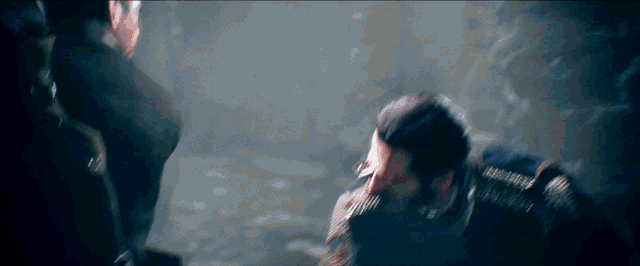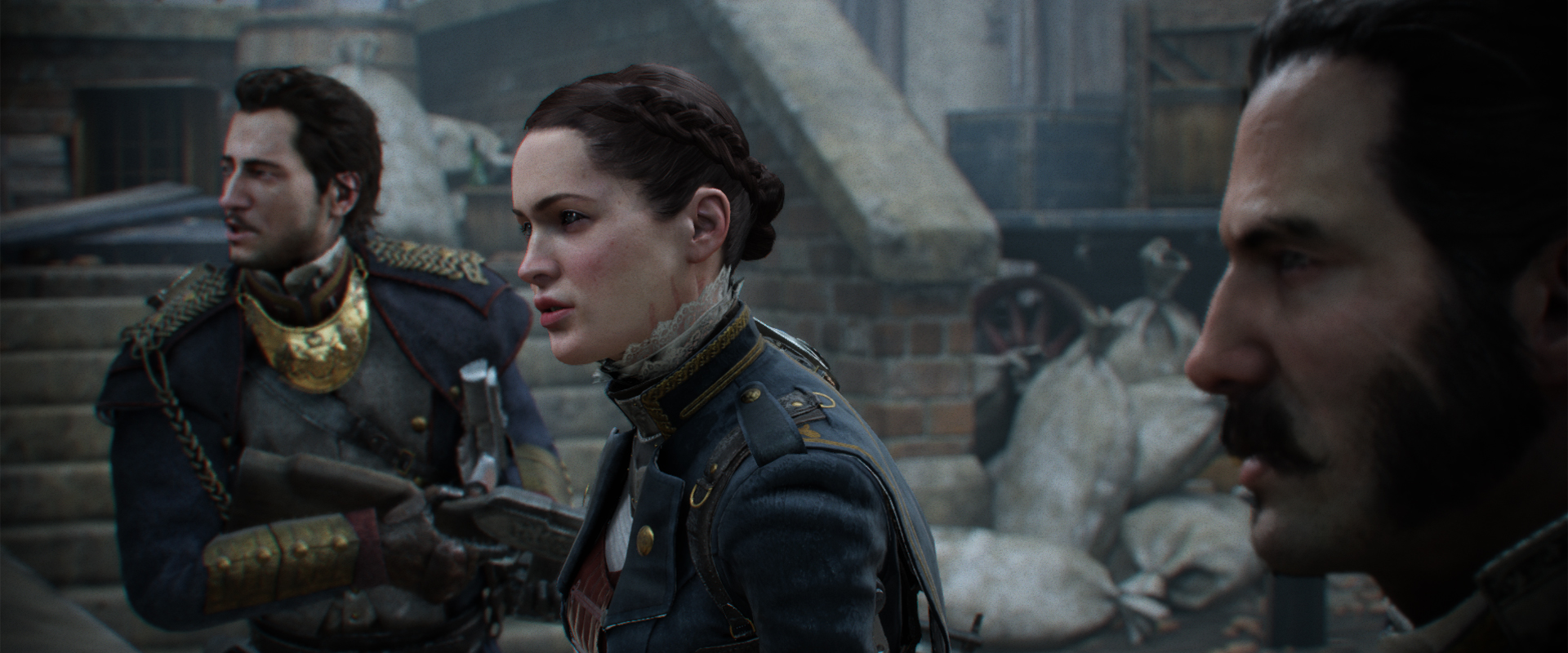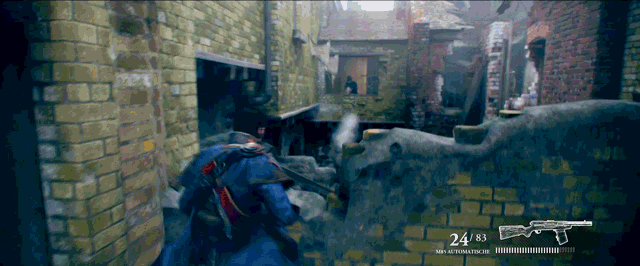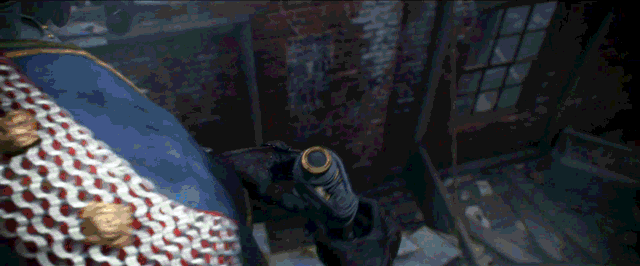The Order: 1886 does what it wants. Zeppelins, elevated trains and automatic rifles? It might not fit the history it’s based on, but hey, why not? Toss them in. Developers Ready at Dawn are telling a story about men and women fighting half-bred monster people that never existed in their own vision of 19th century London.
The Order‘s presentation is as striking as the content. The entire game — cutscene and gameplay — is framed in a 2.40:1 anamorphic aspect ratio (so it looks like a widescreen movie). It runs at 30 frames per second because that delivers a look they like. And they’re taking cues from what other developers have done in order to build the experience they want to give players.
The titular Order refers to a group dating to the Middle Ages who have carried on a millenium-long war with half-breeds who have some beast blood in them. It’s not a straight-up shooter but rather a third-person action adventure in the vein of Uncharted (with cover, of course), and the similarities between Naughty Dog’s franchise and Ready At Dawn’s potential series-starter extend beyond a shared genre.

Aside from the visual fidelity afforded by developing exclusively on the PlayStation 4, the most glaring characteristic of The Order I noticed in the brief hands-off gameplay demo we were shown at a press event in LA last week is its seamless presentation; it goes from cutscene to gameplay without a break, then from shooting to branching quick-time events back to cutscenes with nary a gap to be found. And once you start playing, studio co-founder and creative director Ru Weerasuriya promised me, you’re not going to face a loading screen until the next time you boot up the game.
“The point is immersiveness, making sure the player, once they’re involved, that emotionally they don’t get detached,” Weerasuriya emphasised. “Every single time you break it, regardless of whether it’s a visual break, that changes the way cinematics [change] from gameplay, or whether it’s a loading screen that changes the pacing, all of those are pace-breakers.”
Where you might say the seamless presentation is inspired by Naughty Dog, the QTEs I mentioned are akin to those we’ve seen before in Heavy Rain or The Wolf Among Us. They come in a sequence, and missing a button doesn’t doom you immediately but changes that sequence. Fail too many times and you’re dead, sure, but this is the new age, not the old one. Ready At Dawn wants these QTEs to customise the experience a bit for you, and to be one of many bits of curation the studio is using to deliver its vision.

“Every single element is really there as a tool to deliver an experience,” Weerasuriya told me. “There is no one thing.”
Another of those single elements is the framerate, a contentious point of debate in gaming these days. But bigger is not necessarily better, despite what some people will tell you, because while Peter Jackson may insist that 48 frames per second is the only way to watch a movie now, more folks tend to disagree with that than not. Also, frame-boosting tech on modern TVs — like TruMotion, MotionFlow, ClearScan, etc — are the butt of so many jokes (“I can’t even watch five seconds of it” was all Weerasuriya had to say about that) because the visual difference between high and film-stand framerates is extremely stark.
And while response time is a worthwhile concern — 60 frames definitely feels faster than 30 — Weerasuriya noted the way the game is constructed can eliminate the need for a quicker response.

“You build the game with that in mind, because everything you do is a compromise,” he said.
“Some things are done the way they are because of the experience they’re trying to portray to the player. I think for us 30 frames per second and the anamorphic… is very calculated because it happened very early on.”
Ready At Dawn was from the beginning seeking a specific look and feel for the game. They liked the way 30fps looks versus 60, and they insisted on utilising a 4x multisampling anti-aliasing (MSAA) process — which is quite technically demanding. Between that and any number of other graphical effects they wanted to implement. going with a higher framerate just wasn’t a priority.
“Higher framerate doesn’t equate to better,” Weerasuriya insisted. “The framerate has to satisfy the experience you want to have.”
Phil Owen is a freelance journo with work at VG247, GameFront, Gameranx and many, many other places over the years. You can follow him on Twitter at @philrowen. Send hate mail to phil.r.owen@gmail.com.

Comments
60 responses to “The Order: 1886 Is 30 Frames Per Second And Darn Proud Of It”
It doesn’t matter how you slice it 60fps is always going to be better than 30fps for gaming.
All other things being equal, yeah, 60fps is better. But all other things are rarely, if ever, equal – there’s always going to be a trade off between image quality and frame rate. Sacrifice the frame rate and you can have things like higher resolutions, more effects (particles, lighting, etc), better AA and so on.
The nature of the game dictates which is the better option. E.g. a racing game you’re pretty much always going to want 60fps. But, say, a slower paced stealth game (e.g. The Last Of Us) probably gains more from the improved quality than it would have from a 60fps frame rate.
Also it will look better (more cinematic) at 30 with the extra motion blur. This would be a hindrance in a twitch shooter or racer, but here it’s a definite plus. Tomb Raider at 60 fps looks terrible.
This is definitely true. For example, 48fps looks stunning in documentaries, but in cinematic movies (AT THIS POINT) it’s not really that great… in time, it will get better of course.
30 fps as long as the animation is solid, as long as the game is good, I don’t care if it’s 30 or 60. As long as the animation is good and doesn’t look jittery and crappy.
If this were 15 vs 60 though we’d be talking a whole other kettle of fish.
You need to get much slower than 30 to see judder (unless there is some kind of frame rate discrepancy). Most traditional 2D animation runs at 12fps and no one ever complains. Most anime is shot in 3s which means 10fps. Again, it looks fine. Maybe not quite as smooth as US shows, but nothing that would stop you watching.
48fps on the Hobbit looked awful.
12 fps in traditional animation is not as noticeable due to less movement on the screen etc. However in videogames, the lack of fluidity is very noticeable. Play something like Tombraider for instance, when the framerate dips down to 12-15, then increase it to its standard 30 and you’ll definitely see a huge difference.
That’s true. Especially noticeable with an ever moving camera which 2D animation never has.
I think this is realistically only true when the game is designed for a ‘maximum’ framerate that is higher than systems can even achieve. When the difference is from 60 to infinity, or just 30 all around, you can bet they’re going to make it look good at 30.
I actually liked Hobbit in 48 fps 🙁 It feels so smooooooootthh
48fps will eventually catch on in cinema, just like 3D did….
Oh wait.
I think a more reasonable comparison would be colour film. Initially it was laughed out of theatres, with a few loud but outmanned proponents insisting that it’d get better. 48 fps is still in it’s infancy, and has all the problems that plague any technology at the same state. It lacks supporting technology, particularly regards to the currently quality of CG and blending it with real actors and props. I’d wager 48fps would look brilliant in a pixar toon or something of the like, you just need to give it time before current live action filming techniques and technologies can adapt.
@wallgomez, it’s ok I was just kidding about 48fps. I’m no technophobe and I welcome it openly. I saw some documentary footage recently from the arctic that ran in 48fps running on a 4k tv when I was at a JB Hifi (I think it was the arctic?) all I can say is it blew me away.
48fps will eventually become the standard, no doubt, as we move away from film and solely into digital, when we want more detail on screen etc. The biggest problem we have right now, is the old guard of filmmakers in the industry who always have made films 24-28fps and don’t want to change. Sure the first few films have looked ‘weird’ but then 3D really pops when used properly. While the Marvel movies F***ING SUCK with their 3D, so did Superman… so did nearly every post processed 3D movie… movies such as AVATAR and TRON LEGACY blew me away to no end. TRON LEGACY especially, no movie yet has used 3D to the unbelievable effectiveness that movie did. It was absolutely eyepoppingly glorious and every time I get the opportunity to see the bluray in 3D, I do so.
One of the biggest problems people have at the current time, with movies such as the first Hobbit, was the extended framerate made the FX look cheap and dodgy, which is fair enough, most of the effects weren’t truly designed with this framerate in mind. However by the 2nd movie this had been resolved and by all reports, the FX took a dramatic step up and looked incredible, even moreso in 48fps.
I’m dying to see the new AVATAR movies in 48fps to see what James Cameron can do with it, quality of the movie aside, I want to see what technical feat he can perform. In the past Camerons made the bridge and people have crossed over willingly. Peter Jacksons laid the groundwork now, Camerons going to build that bridge and hopefully many more will follow but with quality work to emphasise how more frames can bring in more detail etc.
The concept of a Star Wars movie for instance, with a lightsaber battle between Jedi with that kind of fluidity? That truly excites me…
I think you’re the only person on the internet who thinks Tomb Rider looked terrible at 60fps. It was fantastic and made the game much more enjoyable.
People here are confusing what we’re used to watching and what is trying to get closer to reality. How many frames per second is reality? Does that look terrible?
We all used to think SD TV was fine and HD TV looked bad with too much detail. Try and watch an old TV show now.
Once we get used to higher frame rates there is no going back. Period.
Hahaha.
I’m not confused. I just prefer a cinematic experience.
Only if you look at it for the frames and not the additional strains you put on your platform.
Normally I would agree. But by the look of how the developers want the game to give you a movie experience, then 30fps is closer to the 24fps of a movie.
As an animator myself, im inclined to agree with ReadyAtDawn. A higher framerate can in many case ruin the look of your animation style, and make it look completely unrealistic.
Too bad that means absolutely nothing unless you’re playing competitive.
The way I see it:
60fps with slightly reduced resolution and/or graphics for multiplayer
30fps with slightly better resolution and/or graphics for singleplayer.
MP is where framerate matters more and adds more to the feel of the game. Framerate is what made CoD king on consoles for so long. It had 60fps on last-gen hardware and that’s what gave it the frantic, fast-paces, arcade-style gameplay. No other game could touch it simply because of that.
You can’t say something didn’t feel lacking when you played CoD then a match of Halo 4 or Battlefield 3 afterwards and found the latter to be more slow-paced and less stimulating. Of course this has changed with the Xbox One and PS4 playing games like Battlefield 4 playing at 60fps.
SP is more about cinematic experiences where you’re supposed to get immersed into the world with great visuals and sound. 30 frames is a good tradeoff if that means better graphics than usual.
I would rather something that plays well and looks meh than something that runs like a bag of dicks and looks good. 30fps has not been considered acceptable since the 90s as far as most pc gamers are concerned. And that sentiment seems to have trickled down to console gamers this generation.
As a PC gamer I love it when console games are at 30FPS if they are going to be multiplat. Once they come to PC its easy to crank up FPS but its hard to create extra fidelity.
Yeah, I remember rocking 60fps on Windows 3.1
Jesus fucking Christ, how am I meant to read the article when you have 3 second gifs all over the place?
😀
Turn off animations in webpages, it makes this site vastly better
What if I want animations on webpages that actually use them well, and don’t aim to make you want to gouge your eyes out from all the shit they stuff on it?
Wait, there actually are webpages like that?
This may sound strange, very very strange, but [whisper]some websites even overplay a button on top of the gif, so the gif doesn’t autostart on page load, and you actually have to activate it manually[/whisper]
Woah that sounds like witchcraft! I can’t be having with any of that!
Lies I tell you, lies!!!
But too much rubbish on pages just causes people to leave over time…
I was just thinking the same thing…seriously getting sick of all the gifs on this site lately..
you’d think the overwhelming hate for the gifs and the lack of “loving’ the fully sick gifs here m8, they totally deepen my game news experience” would send a message to the lovely folks at kotaku
Is it 1080p? If yes, then this is probably going to be the best-looking game so far. 1080p, 30fps, 4x MSAA. Nice.
Until inFamous Second Son hits 😀 😀 😀 😀
with it’s non dynamic shadows and crappy textures :p The developers admitted they had to drop graphical quality for it to run at 1080p
900p they have said
Aw. 🙁
It’s neither actually.
1080p is your resolution. As stated in the article the game has an anamorphic aspect ratio which means you’ll have black bars at the top on bottom of the screen to give it a greater cinema feel.
the black bars aren’t part of the video signal and not included in the resolution.
The 1080 refers to the amount of vertical pixels, so in this case, that will be reduced to 800, but the horizontal count is 1920. That’s full HD.
So rather than 1920 x 1080, it’s 1920 x 800.
That’s the same aspect ratio as The Hobbit on blu-ray.
Hopefully that helped some.
30 seems like an odd choice for a cinematic feel. You’d expect 25 fps, but this is good news. I’m glad people out there realise that the frame rate means nothing other than how the game looks and different games require different looks.
The article says that fps has impact on input lag – which it does. 25fps is not gonna cut it at all.
Ideally, games would be running 50+ fps.
I meant to say 24fps (Which is cinema) but no, I disagree about the 50fps+ completely. I really don’t like that crisp movement that high frame rates give you
Over all these console gamers all of a sudden obsessed with resolution and fps dictating to the devs how they should make there game. It ain’t these things that make a great game it’s the actual gameplay
Ever since the Xbox One started releasing games at 30fps which are 60 pn PS4, it’s become a point of contention. People barely know what 60fps looks like but if the PS4 can do it, Xbots must be weeping in shame, right?
Think it’s just tomb raider that was 30fps, the bigger thing is xb1 720 ps4 1080. its just stupid to me
Looks like a great game. Be one to look out for. Ready At Dawn is a great studio.
It’s a good compromise, bring it down to 30fps and you can increase the graphical fidelity a fair amount. When you’re on the cutting edge visually, an extra 16 milliseconds per frame makes a big difference
By and large, gamers have voted with their wallets, they prefer their games to look a lot better in exchange for them playing a little bit worse.
Also, there are some games where the difference between 30 and 60 fps makes a big impact on the playability and enjoyment, especially multiplayer shooters, but then there are other slower games where it only makes a small impact for the vast majority of people.
Obviously 60fps is better than 30fps, just as 1080p is better than 720p, but most people don’t notice those differences as much as they notice the extra shader effects , higher particle count and increased shadow resolution.
am i the only person wanting to play as the beast-men?
Ugh, can’t see past the Gif sandwich while trying to watch the video…
To all web journalists, please stop putting Gifs at the top and bottom of videos. It’s hideous. It’s annoying. It’s stupid. All of the content is right there in the video anyway, so why on earth do we need the damn Gifs at all??? It doesn’t make you clever, it just frustrates the readers. PLEASE STOP.
*** Upvote if you don’t want anymore Gifs ***
Next gen my left foot, Where is my 60fps 1080p next gen console?
They can spin it however they want, but it doesn’t change the fact that the sole reason these ‘next-gen’ games aren’t running in 1080p at 60fps is because they cant.
For any hardware platform, it’s possible to design a game such that you will need to make tradeoffs. You have a certain amount of CPU, GPU and memory bandwidth with which to model your world, do your AI and represent that on the screen.
It’s not hard to write a design document for a game that the highest spec PC in existence could not run at a decent frame rate.
Framerate; graphical fidelity; complexity of the core game. Any computer/video game involves a tradeoff between these three. Different people will choose different places at which to place emphasis during development. If a game does not require these tradeoffs, it will be because it is not designed for next-gen hardware.
The fact that they’ve chosen 30fps is a good sign. It shows they are pushing the hardware in other ways.
I like 1080 games but not 60fps. Y;know how everybody freaked out that the Hobbot’s high frame rate made it look like it was a soap opera? Well that’s what 60fps games feel like to me.
Read my above comment for why the game isn’t 1080p. 🙂
and I COMPLETELY agree about that soap opera look with games at 60fps!
Huh, I didn’t realise that. To be honest, 720/1080 isn’t that big of a deal to me, my TV is 8/9 feet from my lounge so it makes little difference. But I don’t like 60fps. Strangely though, I do like movies in high frame rates. Weird huh?
thats it… i give up on next/current gen gaming….
and no… it isn’t because of a game dev making the choices they felt were correct in order to bring a solid and probably awesome gaming experience to the hardware they are dealt with… its because of all you numbnuts and “journalists” that keep bringing this shit up… every freakin day there is an “article” about a game not running at 1080p60… if this is seriously what gaming has come to then i’m done… all this bullshit about framerates and screen resolutions is complete and utter nonsense and who cares if a game DOES run at 1080p60 if its shit anyway?
clearly everyone wants high res high framerate piece of shit games? or no its actually sony and microsoft’s fault for not fitting sli titan-like power in a box you plug into your tv and still sell it for $500-600… how dare they!
you’re all a bunch of spoilt cry babies and you’re ruining gaming with this crap…
to those that haven’t bitched about it and accept that some things are better locked at 30 or running a lower resolution than the all mighty 1080p, i apologise, this post isn’t directed at you…
Personally, I have no issues with 30 FPS, but I have nothing but issues with the decision to include QTE’s. They are so very crappy and lazy.
I made a comment almost 2h ago that’s “awaiting moderation”. Any chance of that happening some time soon?
Higher frame rate, Higher resolution is always better. Always. Just tune down the graphics so your game can actually run, as opposed to trying so hard to make it look like there’s an actual difference in graphics quality from last gen to this gen. Which there really isn’t.
People who are complaining about the frame rates of games are usually complaining about the wrong thing. If most games run seamlessly at 30fps, you often won’t even realise that it is running at 30fps compared with 60. What most people notice is not the frame rate, but spikes in frame rate.
Haha, I play heaps of 30fps and 60fps games and have never once noticed the difference. The only thing that gets to me is in games like Uncharted: Golden Abyss the frame rate sometimes drops to below 10. I never saw and never will see 30fps as an issue!
Kotaku! Please stop putting .gifs in between text. It is really distracting to read.